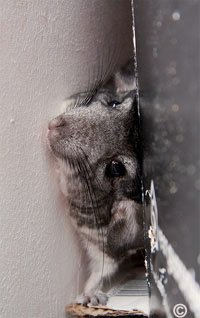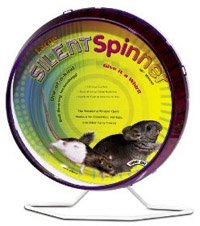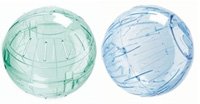 How Do You Get A Chinchilla To Go Home?
How Do You Get A Chinchilla To Go Home?
Ok, so this is where the problem lies unless you have got the routine correct. If a chinchilla does not have enough time out of its cage on a regular basis then you will have a problem with them returning on their own accord.
Chinchillas are sticklers for routine and have long memories. If you are in a regular routine of allowing a chinchilla exercise outside its cage environment for 1-2 hour/night and feed them directly on their return home, you will never have a problem!
If You Notice A Chinchilla Doesn't Want To Return To Its Cage On A Regular Basis...
Change cage - Review the cage: is the cage big enough or could it be made bigger? Are there many toys and items to gnaw on inside the cage? Is the cage in a noisy environment? Is the cage clean and regularly maintained?
Reassess exercise time - Chinchillas love to run freely and bounce of walls, if they don't get long enough to expel some of this energy they will begin to retaliate going back into their cage. Ensure a chinchilla has a minimum of 1-2 hours outside of the cage environment nightly. A chinchilla that does not want to return to its cage maybe trying to tell you that's he's not had long enough playtime.
Do not offer treats other than for training purposes or good behavior - If you regularly feed a chinchilla treats you will not only have a seriously unhealthy chinchilla on your hands but there is no incentive for a chinchilla to leave the wide open space of a living room, for example, and return to its humble cage for dinner. You will also not be able to bribe a chinchilla with treats (if needed) or be able to use the treat as a praise for returning to the cage if the chinchilla has already been given them. Chinchillas are seriously clever and once they have had one treat, they can happily give up another if it means freedom for a bit longer.
Make the area the chinchilla explores less interesting and more interesting within cage - If a chinchilla's cage is boring it will never want to return to its home environment. Any chinchilla toys that you have put around the area can be collected up and moved back into the cage. This will begin to symbol the end of playtime to a chinchilla and if you stick with a routine, the chinchilla will know dinner is on the way  and automatically be sitting in its cage waiting.
and automatically be sitting in its cage waiting.
Get a chinchilla wheel...a chinchilla may be bored in its cage and enjoy running so much it doesn't want to return. If this is the case then you can now buy a variety of chinchilla wheels that can be securely fixed into the cage area for the chinchilla to use at its own accord.
What Do You Do If Your Chinchilla Escapes...
If a chinchilla manages to escape after all the chin-proofing you thought you had done, then stay calm and isolate the area the chinchilla is in. Ensure the isolated area is chinchilla proof by removing wires and lethal objects and place a dust bath into the middle of the area. Sit back and wait for the chinchilla to emerge. When the chin does surface, quickly move your hand to block the entrance of the hidden spot. Pick the chinchilla up and place him back into his cage.
For more tips on Catching a Chinchilla click here. It is advisable to ensure you are confident with handling a chinchilla before you allow them to exercise outside their cage otherwise it can be difficult to get them to return when exercise time ends.
 Chinchilla Exercise Wheel
Chinchilla Exercise Wheel
A chinchilla wheel should not be the only form of exercise your chinchilla receives! A chinchilla should always be allowed to run freely outside of its cage environment but chinchilla wheels can also be placed inside the cage as extra exercise for your pet to run on.
Not all chinchillas will like an exercise wheel so do not be disappointed if you do get one and it just sits in the cage collecting dust or the chinchilla uses it as a shelf.
Care must be taken when buying an exercise wheel as some can be seriously dangerous to a clumsy chinchilla either ripping their feet off or getting their head jammed in the spokes! Therefore, if you buy an exercise wheel it must meet certain requirements.
- A chinchilla exercise wheel should only be considered if it has a minimum 15” diameter as anything smaller than this could cause spinal damage!
- The chinchilla exercise wheel must have a solid running surface and not be made of wire mesh as chinchillas can easily trap their feet between the gaps or rip their feet off.
- The running surface of the exercise wheel must be at least 5" wide.
- The wheel itself must be secured to the chinchilla cage so it cannot fall over or on top of another chin.
- Never buy a chinchilla exercise wheel that has a spoke running through the middle of the wheel as the chinchilla can easily trap its tail and cause spinal damage as they arch their back to allow for the positioning of the spoke.
- As chinchillas chew everything, the wheel must also be made of a safe material that is not detrimental to a chinchilla if chewed.
A chinchilla wheel can seriously injure a chinchilla if not used properly!
The position of the chinchilla wheel is equally important as at first chinchillas will not know what it is for and will generally jump on top of it and start running at full speed only to be catapulted across the cage potentially causing broken limbs and concussion.
It is wise to secure the exercise wheel to the cage close to the floor so chinchillas cannot get trapped under it and position a shelf across the top so other chinchillas will not jump on top whilst the wheel is moving.
Chinchillas can considerably benefit and have noticeable personality differences when placing a chinchilla  wheel within the cage but caution must always be maintained!
wheel within the cage but caution must always be maintained!
THE FLYING SAUCER WHEEL
This is one the latest inventions in chinchilla exercise wheels. The Flying Saucer Wheel is a unique design that enables a much more natural running position for your pet chinchilla. It does not have to arch its back as it would in a regular exercise wheel, and there is plenty of room for a bushy tail to bob around together with a flat running surface to ensure no paws or legs get caught in spokes.
The genuine Flying Saucer Wheel is all metal construction so no bits to nibble, and runs on sealed bearings for a smooth ride and a long life. They are easy to clean with a damp cloth and hygienic with minimal edges or moldings. The edges are rolled so there are no sharp ridges that could injure your pet.
The standard sized Flying Saucer Wheel is 13.5" in diameter and will fit through any cage door around 10" by 10" and comfortably support up to 1.25kg - for the chunkiest of chinchillas!
The unique dished design of the Flying Saucer Wheel has the same effective diameter of a regular drum wheel 22" high!
Make sure that the wheel is fitted close to the bottom of the cage to reduce the chance of any high speed falls. Also remove the wheel if any new born kits are in the cage - they risk being launched at high speed across the cage if an adult is already running on it.
The Flying Saucer does take up a bit more cage space than a conventional wheel and, in our experience;  chins do take a little longer in learning how to run on this type of wheel.
chins do take a little longer in learning how to run on this type of wheel.
CHINCHILLA EXERCISE BALLS
You can also purchase giant exercise balls, which open up for a chinchilla to be placed inside then securely closed before the chinchilla is allowed to run around the room.
Exercise balls are seriously inadvisable and can be fatal to a chinchilla!
All exercise balls are too small for a chinchilla and can cause fatal heat exhaustion! The chinchilla will also use the ball as a toilet and will then commence to roll around in their own urine and faeces. DO NOT USE A CHINCHILLA EXERCISE BALL AT ANY TIME!
Further Reading Relating To Chinchilla Exercise:
Catching a Chinchilla, Holding a Chinchilla, Chinchilla Cage, Chinchilla Health, Chinchilla Care, Taming A Chinchilla.






